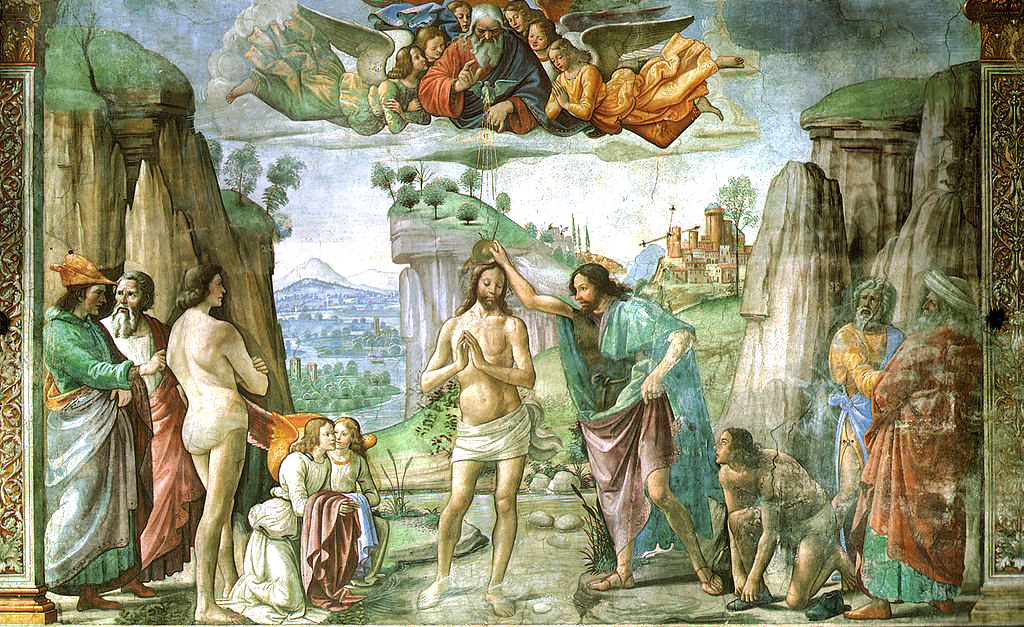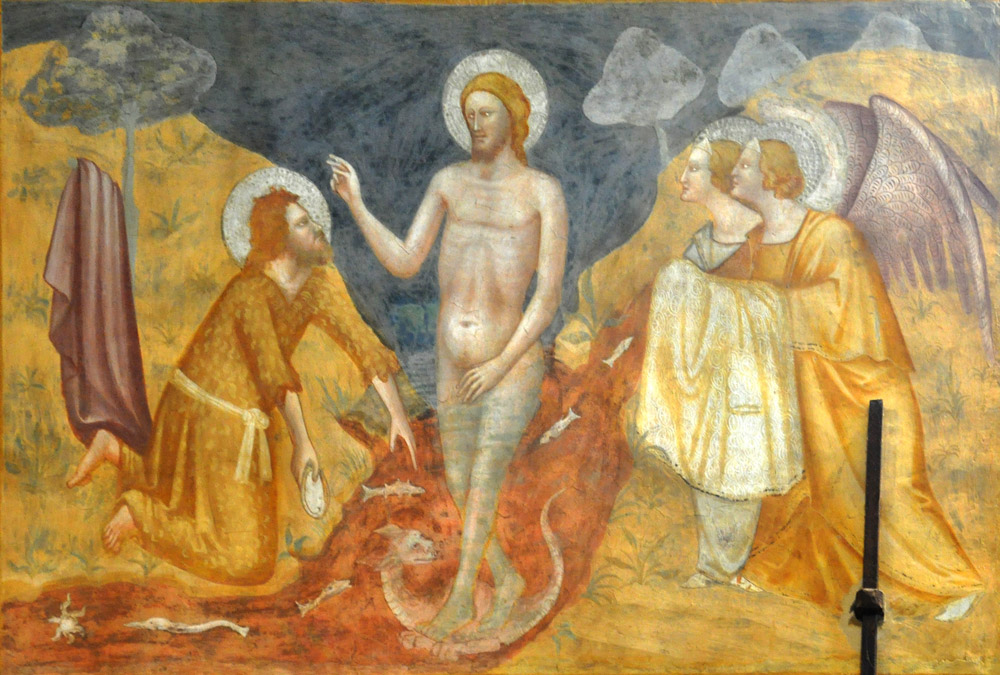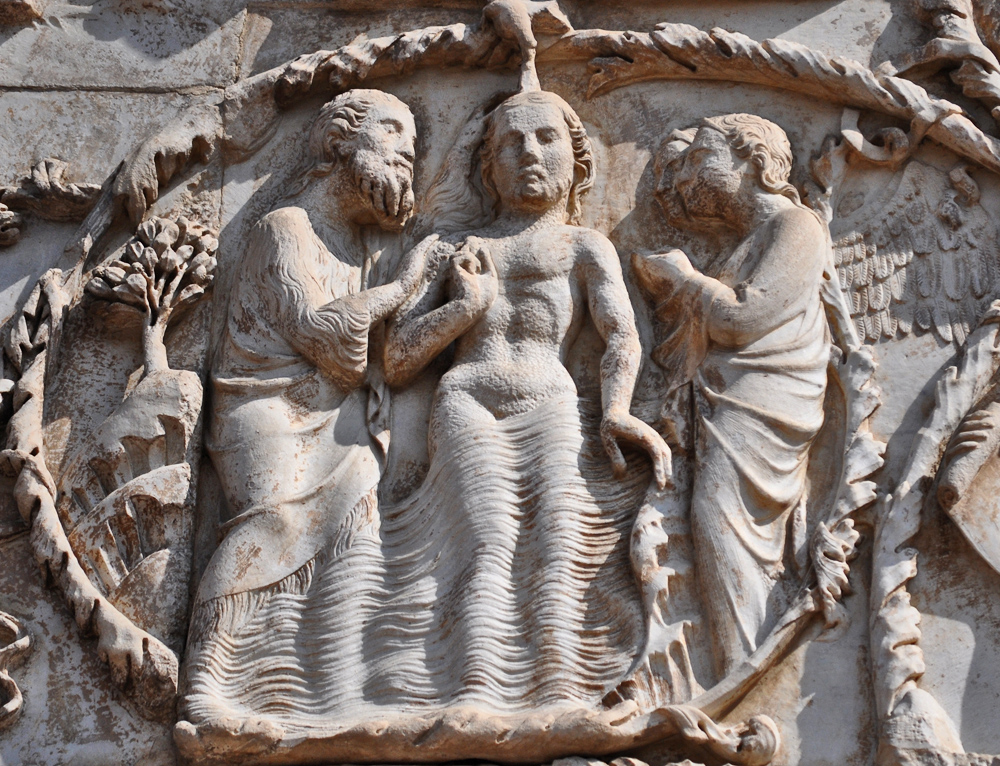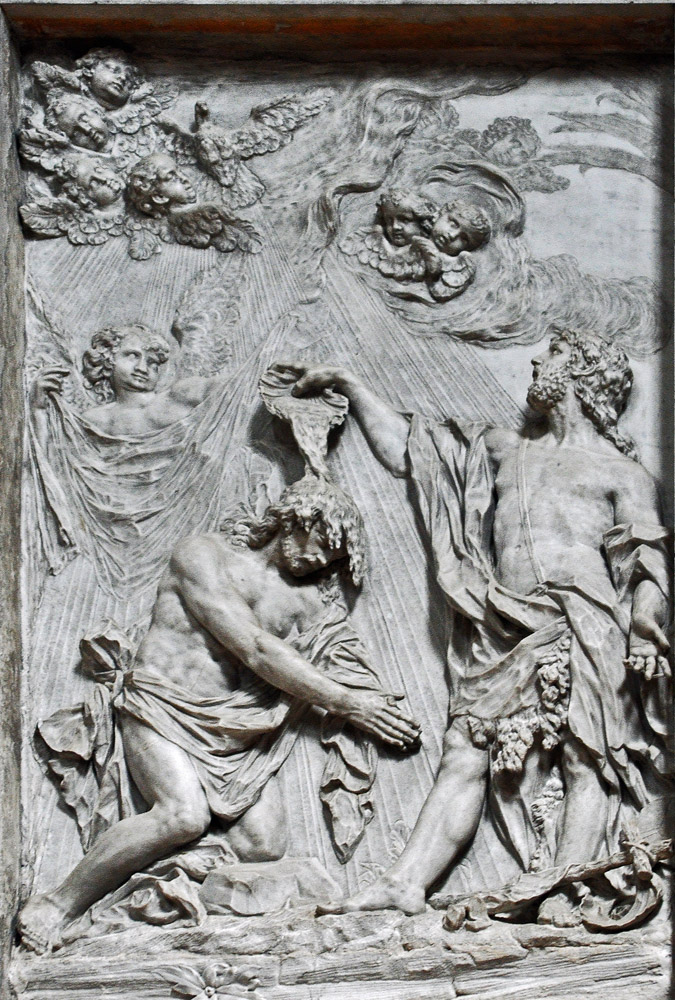

|
The picture above typifies Baptism of Christ iconography. Jesus stands in the Jordan while angels hold his garment on one side and John the Baptist pours water on his head. A dove descends from on high. Above the dove, especially in later images, there may be a human figure or hand representing the Father. In some very early examples Jesus may be pictured as much smaller than John
(example).
This scene actually combines two successive moments in the Gospel narratives: John's baptism first, and after that the descent of the Holy Spirit. It is also possible to picture what took place just before the baptism when Jesus told John, "Suffer it to be so now, for so it becometh us to fulfill all justice." This is the moment portrayed in the first image at right. HUMANITY CLEANSED IN THE JORDAN Variations on this basic pattern arise mostly from commentaries on the gospel narratives. For example, the Catena Aurea teaches that humanity itself was cleansed when Jesus was bathed in the waters of the Jordan.1 This notion finds expression in the art of every era. In the paleo-Christian era some images have John dressed as a bishop, which Jensen (14-15) argues is meant to express a mystical linkage between Christ's baptism and that of Christian neophytes. In a 12th-century mosaic in Sicily, two small figures are in the water with Jesus riding dolphins, which are a symbol of the resurrection (Sill, 19). A Byzantine icon fills the water with apparently dead figures echoing those seen in many representations of Noah's Flood, which 1 Peter 3:20-21 proposes as a type of Baptism. In the Renaissance, figures are added to the scene who are removing their shoes to prepare for immersion, as in the picture above in Florence and this mosaic in Orvieto. And in a remarkable fresco in South Tyrol Christ's baptism is attended from the perspective of eternity by a host of angels and saints, the latter of course representing the multitudes whose salvation he effected.In the Tyrolean fresco we also see a detail found occasionally in other Baptism of Christ images. In the water with Jesus we see drowned human figures with twisted limbs. Commentaries on the baptism narratives recall the soldiers of Pharaoh who perished in the Red Sea. They see in these drowned men a symbol of the sins of mankind that are washed away in Christian baptism.2 THE CLEANSING OF THE JORDAN'S WATERS The commentators posit that even water itself was healed by Christ's baptism in it. Cyril of Jerusalem, for example, says that this was the time when Christ vanquished the "dragon" said to have dwelt in the Jordan, so that Christians in turn could receive power to tread on "serpents and scorpions."3 In the Baptism fresco at Pomposa Abbey (first picture on the right) Jesus treads on a dragon in a Jordan infested by serpents and scorpions.It was significant to the commentators that the Jordan is the only river said to have backed up of its own accord, when Joshua and the Israelites approached it for the first time with the Ark (Joshua 3:14-17). They take it as a symbol of how the candidate for Christian baptism should pull back from his life of sin.4 For this reason, some of the images show Jesus in water that piles up around him, as in this 10th-century relief in Switzerland or this one from the 13th century in Croatia. LITURGICAL INFLUENCES In the early centuries Christians were ordinarily baptized by immersion after removing all their clothes. Thus in Ravenna we see an utterly naked Jesus waist-deep in the Jordan in both the dome of the Arian baptistery (late 5th century) and the ceiling of the slightly later Neonian baptistery. To judge from the Neonian Baptistery's depiction, the rite may have included "sprinkling" (pouring from a dish over the candidate's head) in addition to immersion. In the West, however, sprinkling gradually replaced immersion, so most medieval and later images are like the one at the top of this page. They show John pouring water on Jesus' head – not placing his hand on his head as if to immerse him, as in the Arian Baptistery dome. Usually they reduce the old image of a deep or piled-up Jordan to just a shallow stream (example) or even a dry wadi, as in this painting in Trogir Cathedral in Croatia.As the Trogir painting exemplifies, we do not see Jesus fully nude in these later images. Instead he wears a perizoma just like the one we see in Crucifixion images of the period, or the water is kept opaque to hide the lower half of his body (example). What we do find is a greater emphasis on the Father, who is represented by a human figure in the clouds above attended by angels.
Prepared in 2016 by Richard Stracke, Emeritus Professor of English, Augusta University.
|
MATTHEW 3:13-17 — Then cometh Jesus from Galilee to the Jordan, unto John, to be baptized by him. But John stayed him, saying: I ought to be baptized by thee, and comest thou to me? And Jesus answering, said to him: Suffer it to be so now. For so it becometh us to fulfill all justice. Then he suffered him. And Jesus being baptized, forthwith came out of the water: and lo, the heavens were opened to him: and he saw the Spirit of God descending as a dove, and coming upon him. And behold a voice from heaven, saying: This is my beloved Son, in whom I am well pleased. MARK 1:9b-11 — Jesus came from Nazareth of Galilee, and was baptized by John in the Jordan. And forthwith coming up out of the water, he saw the heavens opened, and the Spirit as a dove descending, and remaining on him. And there came a voice from heaven: Thou art my beloved Son; in thee I am well pleased. LUKE 3:21-22 — Now it came to pass, when all the people were baptized, that Jesus also being baptized and praying, heaven was opened; And the Holy Ghost descended in a bodily shape, as a dove upon him; and a voice came from heaven: Thou art my beloved Son; in thee I am well pleased. 
From the frescos in the nave at Pomposa Abbey – See the description page 
Detail from the façade of Orvieto Cathedral – See the description page 
A rococo take on the iconography – See the description page. MORE IMAGES
PUBLISHED IMAGES
DATES
RECOMMENDED READING
NOTES
|